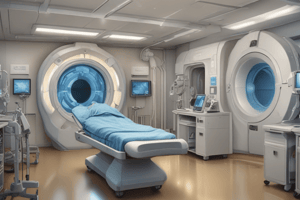Podcast
Questions and Answers
What is the advantage of using Fast Spin Echo sequences?
What is the advantage of using Fast Spin Echo sequences?
- Reduced susceptibility artifacts
- Improved spatial resolution
- Increased signal-to-noise ratio
- All of the above (correct)
What is the main limitation of Single-Shot Fast Spin Echo sequences?
What is the main limitation of Single-Shot Fast Spin Echo sequences?
- Low signal-to-noise ratio (correct)
- Increased SAR
- Poor spatial resolution
- Long acquisition times
What is the purpose of the initial 180° inverting pulse in Inversion Recovery sequences?
What is the purpose of the initial 180° inverting pulse in Inversion Recovery sequences?
- To flip the longitudinal magnetization into the +z-direction
- To reduce T1 relaxation time
- To flip the longitudinal magnetization into the −z-direction (correct)
- To increase the signal-to-noise ratio
Why do FSE images often appear brighter in fatty tissues?
Why do FSE images often appear brighter in fatty tissues?
What is the advantage of using fat saturation techniques in FSE sequences?
What is the advantage of using fat saturation techniques in FSE sequences?
What is the main disadvantage of using multiple 180° pulses in FSE sequences?
What is the main disadvantage of using multiple 180° pulses in FSE sequences?
What is the advantage of using half-Fourier acquisition techniques in Single-Shot FSE sequences?
What is the advantage of using half-Fourier acquisition techniques in Single-Shot FSE sequences?
What can be used to decrease the SAR in FSE sequences?
What can be used to decrease the SAR in FSE sequences?
What is the typical scan time for both PD and T2 weighting?
What is the typical scan time for both PD and T2 weighting?
What is one advantage of Spin Echo sequences?
What is one advantage of Spin Echo sequences?
What is the disadvantage of Spin Echo sequences in terms of tissue heating?
What is the disadvantage of Spin Echo sequences in terms of tissue heating?
What is the main difference between Fast Spin Echo and Turbo Spin Echo?
What is the main difference between Fast Spin Echo and Turbo Spin Echo?
What is the purpose of the 180° rephasing pulses in Fast Spin Echo?
What is the purpose of the 180° rephasing pulses in Fast Spin Echo?
How does the echo train length (ETL) affect the scan time in Fast Spin Echo?
How does the echo train length (ETL) affect the scan time in Fast Spin Echo?
What does the echo train length (ETL) represent?
What does the echo train length (ETL) represent?
What is the advantage of Fast Spin Echo in terms of spatial resolution?
What is the advantage of Fast Spin Echo in terms of spatial resolution?
What is the purpose of using a saturation band in Magnetic Resonance Imaging?
What is the purpose of using a saturation band in Magnetic Resonance Imaging?
What is the primary factor that affects the scan time in Conventional Spin Echo (SE) pulse sequences?
What is the primary factor that affects the scan time in Conventional Spin Echo (SE) pulse sequences?
Which of the following gating techniques can be used to compensate for cardiac motion?
Which of the following gating techniques can be used to compensate for cardiac motion?
What is the benefit of swapping the phase direction of motion in Magnetic Resonance Imaging?
What is the benefit of swapping the phase direction of motion in Magnetic Resonance Imaging?
How can the scan time in Conventional Spin Echo (SE) pulse sequences be reduced?
How can the scan time in Conventional Spin Echo (SE) pulse sequences be reduced?
What is the primary advantage of using Conventional Spin Echo (SE) pulse sequences in Magnetic Resonance Imaging?
What is the primary advantage of using Conventional Spin Echo (SE) pulse sequences in Magnetic Resonance Imaging?
Flashcards are hidden until you start studying
Study Notes
Machine Dependent Artifacts
- Solutions to artifacts include gating, saturation bands, and swapping phase directions
- Gating compensates for respiratory, heart, or vascular motion
- Saturation bands can be used to reduce vascular motion and suppress structures in motion
- Swapping phase directions can place motion away from structures of interest
Pulse Sequences
- Conventional Spin Echo (SE) pulse sequence
- Scan time in conventional SE is a function of TR, NEX, and number of phase encoding steps
- Very fast sequence allows for reduced scan time by filling multiple lines of k-space
- Advantages of Fast Spin Echo (FSE) include improved spatial resolution and reduced susceptibility artifacts
- Disadvantages of FSE include reduced detection of small areas of calcification or hemorrhage, inability to detect fat, and increased magnetization transfer effects
Fast Spin Echo (FSE)
- FSE uses a 90° flip angle followed by several 180° rephasing pulses to produce multiple SE in a given TR
- Echo train length (ETL) or turbo factor determines the number of 180° rephasing pulses
- Scan time decreases by ETL (turbo factor)
Single-Shot FSE (SS-FSE)
- SS-FSE acquires half of k-space in one shot with half-Fourier acquisition techniques
- Advantages include very rapid acquisitions, suitable for multiple-slice breath-hold and real-time imaging
- Disadvantages include reduced SNR due to half-k-space acquisition
Inversion Recovery Sequence
- Mechanism involves a 180° inverting pulse, followed by parameters for PD or T2 weighting
- Parameters for PD weighting: Short TE (20 ms), long TR (2000 ms+), and typical scan time (7-15 min)
- Parameters for T2 weighting: Long TE (80 ms+), long TR (2000 ms+), and typical scan time (7-15 min)
Advantages and Disadvantages of SE and FSE
- Advantages of SE: good image quality, high SNR, easy to understand image contrast, less artifact
- Disadvantages of SE: long scan time, long TR, high SAR
- Advantages of FSE: improved spatial resolution, reduced susceptibility artifacts
- Disadvantages of FSE: reduced detection of small areas of calcification or hemorrhage, inability to detect fat, increased magnetization transfer effects
Studying That Suits You
Use AI to generate personalized quizzes and flashcards to suit your learning preferences.




